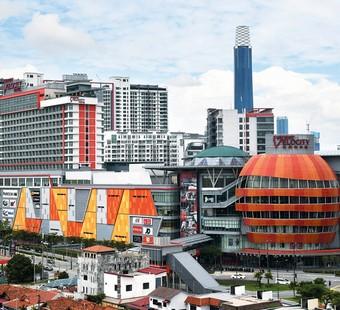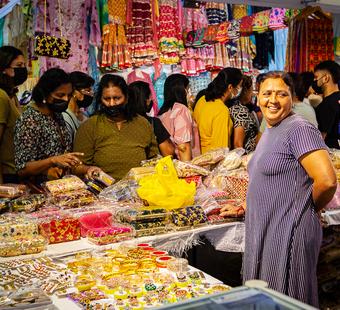Centuries of travel, trade and cultural exchange from India left a strong mark on Southeast Asia, In Malaysia, hybridised versions of vernacular designs that took on Indianate influences can be seen in traditional Malay houses, palaces and even mosques.
However, the vast majority of Indian and Indian-inspired structures in the capital city’s built environment have a much more recent provenance.
Developments in the Colonial period
Kuala Lumpur’s founding coincided with the late colonial period’s economic boom which saw large migrant populations flocking to what was then Malaya. Among them were various Indian communities, most of whom came from South India as indentured labourers, but there were also traders, soldiers and colonial administrators.
Houses of worship were built to serve these populations, and South Indian-style temples continue to be the most common form of Indian architecture in the city today. These single-storey temples were modelled on those in India, but were built on a smaller scale and adapted to local needs and materials.
Builders have taken care to ensure that, despite the smaller size, the most essential elements of a South Indian temple are incorporated properly. This includes the gopuram tower, flag pole, pedestal, main hall and the inner sanctum for the primary deity. These elements are also symbolically associated with the human body; the gopuram representing the feet, the flag pole the reproductive organs and the sanctum acts as the head, or the ruler.
The oldest Indian temple in KL is the Sri Mahamariamman temple, which was a mere attap structure when it was first constructed in 1873. It was moved to its current location in 1885 when a more permanent building was erected. G. Shanmuganathan, Vice Chairman of Malaysia Hindu Sangam points out that Sri Mahamariamman is a major temple and not just a shrine, since it has a large Raja Gopuram of intricate beauty.
“The five gold kalasam at the top represents the supreme principles of Hinduism and identifies it as a Shaivite temple,” Shan says. Each kalasam is shaped like an inverted pot, topped by a point reaching to the sky, and crowns the gopuram tower.
The pride of the temple is a silver chariot used to transport the statue of Lord Murugan during Thaipusam festivities.
Victorian Neo-Mughal architecture
Perhaps the most iconic Indianate style to be found in KL is actually more of a British innovation than an indigenous Indian invention. The Neo-Mughal style (also known as Indo-Saracenic) characterises such institutions as the KL Railway Station and Masjid Jamek.
This Anglo-Indian architectural adaptation was popular during the Victorian period inspired by the grand Mughal structures that colonials encountered in India. One popular feature is the chhatri, which are elevated, dome-shaped pavilions. The word chhatri means "canopy" or "umbrella”, and the style has roots in Rajasthani architecture, and has been used continually to the present day, regardless of religious affiliation.
This feature can be seen clearly whether as part of Emperor Akbar’s Fatehpur Sikri or in KL’s Masjid Jamek designed by English architect, Arthur Benison Hubback, who had worked for a time in the Public Works Department in India.
In the Neo-Mughal style during the colonial period, the chhatri, alongside other aesthetic references such as facades, domes, roofs and other decorative elements, mimicked the grandeur of Mughal monuments.
However, the basic layouts and structures were closer to that used in contemporary Victorian buildings of other styles, such as Gothic revival and Neo-Classical.
In contrast, actual Mughal buildings had floor plans with cosmological implications; resembling mandalas, star systems or Edenic references that all lead to one central point. This is why Mughal buildings are generally rather fat and square, while colonial Neo-Mughal structures can be quite narrow such as the Sultan Abdul Samad building.
“Their floor plans more closely resemble a Victorian post office in Manchester than the Mughal marvels they were modelled after, such as Fatehpur Sikri and the Taj Mahal,” architect Ihsan Hassan from VERITAS Architects explains.
Creative confluences
The Indian and Indian-inspired architecture of KL traces the many ways that cosmopolitan cultures interacted through the years. Various styles developed as ethnicities and civilisations interacted to create a built environment suitable for local needs and the evolution of the times.
Other Anglo-Indian colonial archetypes can be seen in Indian buildings, such as the Vivekananda Ashram in Brickfields. The Ashram is typical of the colonial bungalow style being a spacious, one-storey building with a symmetrical internal layout, and situated in a large, landscaped compound.
One intriguing example of cultural confluence is seen in Loke Hall, which long-housed the headquarters of the Malaysian Institute of Architects (PAM). The building is made in the Chinese colonial mansion style, but is said to have had an Anglo-Indian architect, namely A.K. Musdeen.
The grand home would become the Empire and Peninsula hotels in the early twentieth century, and is today the head office for the Kuala Lumpur Tourism Bureau. As relations and migrations with India continue alongside the longstanding cultural vibrancy of the Malaysian Indian community, Kuala Lumpur is sure to be home to exciting architectural innovations reaching far into the future.
Photo credit: Vincent St Thomas







